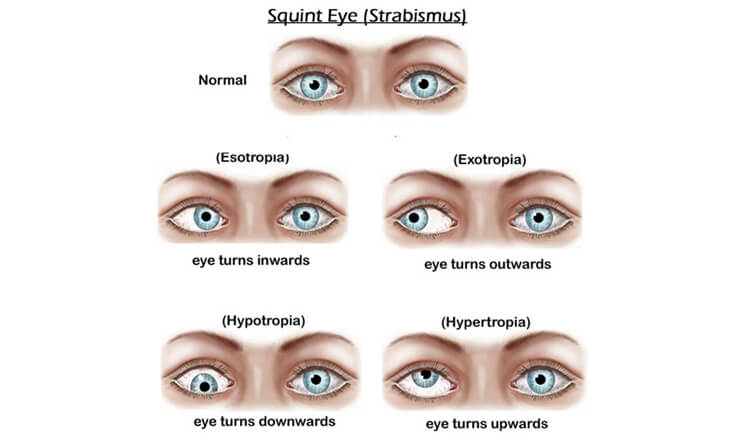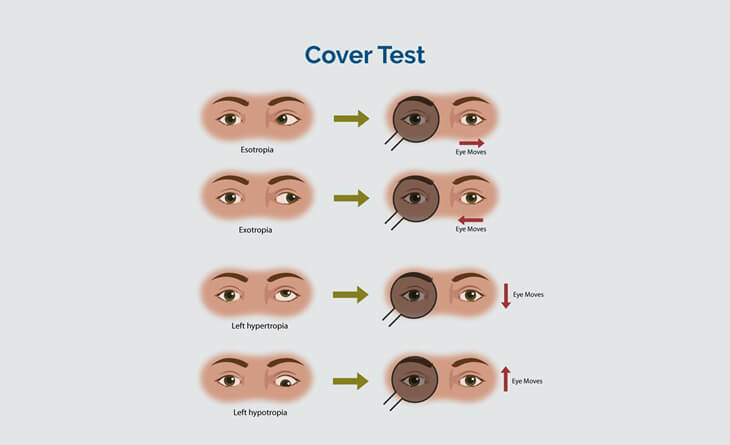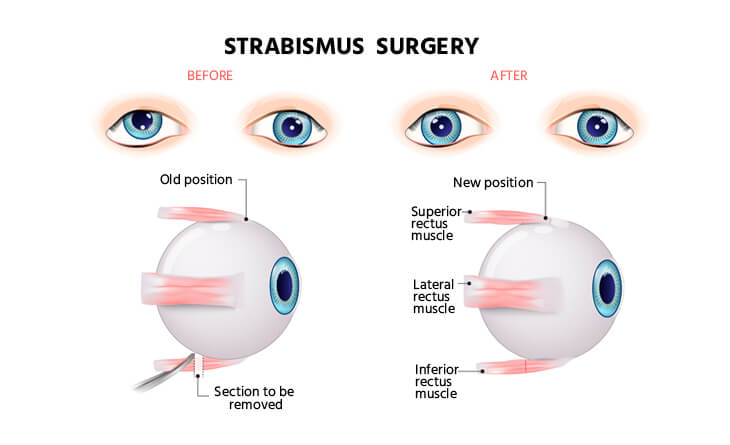Squint Eye Surgery: Types, Causes, Treatment and Cost
Imagine the world with eyes that don’t focus on the same point. One eye drifts inward, outward, or even up, while the other stares straight ahead. This is what the doctors call squint, also known as strabismus.
Squint can affect people of all ages, but it’s particularly common in children. This misalignment prevents the eyes from focusing together on the same object, causing frustration and having a significant impact on vision, depth perception, and even self-esteem.
But thankfully, with the advancements in medicine, treatment options are available. One of the most effective treatments is squint eye surgery. It will not only correct your vision problem but also improve your quality of life.
In this comprehensive guide, we will discuss the different types, causes and treatment options for squint. Keep reading!
What is Squint?
First things first: What is this squint?
A squint, also known as strabismus or lazy eye, is a medical condition where the eyes don’t align properly and focus in the same direction at the same time. In healthy eyes, both eyes focus on the same object. However, in strabismus, one eye focuses on a different spot, leading to either blurry vision and difficulty seeing clearly or diplopia or double vision.
The eyes appear crossed, turned inwards, outwards, upwards, or downwards. Squint can affect one or both eyes and be constant or intermittent.

Types of Squints
Based on the direction of the eye’s misalignment, squints are classified into two types: esotropia and exotropia.
Esotropia (Convergent Squint): This is one of the most common types, where one eye turns inwards towards the nose. It can be present from birth due to underdeveloped or imbalanced eye muscles or can develop later in life, often triggered by vision problems, uncorrected refractive error, neurological conditions, or trauma.
Exotropia (Divergent Squint): In exotropia, one eye turns outwards, away from the nose. It’s less common than esotropia and can also be constant (present all the time) or intermittent (appears only under certain circumstances).
People can also experience vertical misalignment, hypertropia or hypotropia in their eyes. In hypertropia, one eye turns upwards while the other remains straight. On the contrary, in hypotropia, one eye turns downwards while the other remains straight.
Causes of Squint
The squint, or strabismus, can occur as early as a six-month-old baby or later in life due to different reasons. Therefore, it is essential to find the underlying cause of the eye’s misalignment to find the most effective squint eye treatment. So, let’s see what causes squint eye.
Muscle Imbalance: The major culprit behind squint eye is an imbalance in the six muscles that control each eye’s movement. Some muscles might be weaker or stronger than others, causing the eyes to pull in different directions.
Neurological Issues: Certain neurological conditions like traumatic brain injury and stroke can affect the nerve system controlling eye movement, leading to misalignment of the eyes, which can cause discomfort and vision problems.
Genetic Factors: Some people inherit a genetic tendency to develop squint, especially if family members have it.
Medical Condition: Certain medical conditions like thyroid disorders, diabetes, or infections can also contribute to squint, especially in adults.
Vision Problem: Uncorrected refractive errors like nearsightedness, farsightedness, or astigmatism can force the eyes to work harder to focus, leading to misalignment.
Other Contributing Factors: Premature birth, low birth weight, and certain medical conditions like cerebral palsy can also increase the risk of developing squint. Trauma to the head can also damage the eye muscles or nerves, leading to squint. Certain congenital conditions and syndromes are also associated with squints.

Symptoms of Squint
The symptoms of quint can vary based on the type or severity of misalignment of eyes; however, the most common symptoms may include:
- Misaligned eyes
- Poor or double vision
- Blurry vision
- Poor depth perception
- Headaches and eye strain
- Squinting or closing one eye
- Tilting or turning the head
- Difficulty in performing daily tasks that require concentration, like reading or writing
Diagnosis and Tests for Squint
A proper diagnosis is one of the most effective approaches to getting a personalized squint eye treatment. The comprehensive diagnosis procedure of squint includes:
A Complete Eye Exam: The first and foremost step to check the severity of the condition is a thorough assessment of your eyes and vision. During this assessment, your eye doctor will take your medical and family history, perform visual acuity tests, check your retina and optic nerve, and evaluate any noticeable misalignment, head posture, or eye movement abnormalities.
Visual Activity Test: In this exam, your eye specialist in Delhi asks you to read letters from an eye chart so that they can assess your child’s visual abilities.
Refraction: In this test, a lens is used to detect how light focuses on the retina, identifying refractive errors that may contribute to squint.
Corneal Light Reflex Test: During this test, your eye doctor will flash light on the cornea to observe the reflection’s position. Depending on the light reflection, they diagnose whether you have a divergent or convergent squint.
Cover Test: It is a simple but effective test where one eye will be covered, while you will be asked to focus on the target with an uncovered eye. The movement of the uncovered eye reveals the presence and type of squint.
Prism bar cover test: This test calculates the amount of squint in degrees and prisms. This is important for pre-operative evaluation and planning of surgery.

Squint Eyes Treatment
Basically, both non-surgical and surgical treatment options are available. Based on the complete assessment and type of your squint, your eye specialist in Delhi will prescribe the most suitable treatment option.
Non-Surgical Treatment
Glasses: If refractive errors like nearsightedness, farsightedness, or astigmatism cause squint, your eye doctor will recommend eyeglasses to improve eye alignment and vision.
Vision Therapy: To treat mild squint or intermittent squint, your doctor may prescribe some eye exercises to strengthen eye muscles and improve coordination. These exercises might involve activities like tracking objects, using prisms or wearing special glasses.
Patching: Patching is one of the most effective non-surgical squint eye treatments for lazy eye due to squint, where your stronger eye is covered with a patch to encourage the weaker eye to work harder and improve its vision. It’s often recommended in conjunction with glasses or vision therapy to treat amblyopia.
Medications: In some cases, your eye specialist may prescribe eye drops or eye ointment. Sometimes, Botox injections are also used to temporarily weaken certain eye muscles to adjust the alignment. This is done in adult squints only.
Surgical Treatment
All the treatments mentioned above are temporary solutions that can correct eye muscle or vision problems for a short time. Then what is the permanent solution? Squint eye surgery can give hope to those struggling with misaligned eyes. It’s not just about aesthetics; this surgery will help you restore lost vision and improve depth perception and overall eye health.
Strabismus surgery involves adjusting the muscles that control eye movement. By carefully weakening or tightening specific muscles, the surgeon can realign the eyes so they focus together on the same object.
Squint eye surgery is typically performed under local or general anesthesia. The entire process usually takes around 30-60 minutes. After putting you under anesthesia, your eye doctor will place a lid speculum to keep your eye open. Afterward, a small incision is made in the conjunctiva, the thin membrane that covers the white of the eye. Then, the muscles causing the misalignment are identified and adjusted as needed. After making the required adjustments, incisions are closed with absorbable sutures.
After surgery, you can expect some eye pain, itchy eyes, redness in your eyes, or double vision for a few days. Your eye specialist in Delhi will provide instructions on how to care for your eyes and manage any discomfort. Sticking to those instructions can help you have a smooth and quick recovery. Most people recover fully within 7-10 days and resume their daily life activities.
Squint eye surgery helps to treat moderate to severe strabismus that hasn’t responded well to other treatments like glasses or vision therapy. It can be performed at any age, but early intervention in children is often recommended to prevent potential vision problems. Squint eye surgery can help you prevent lazy Eye or amblyopia, decrease diplopia, reduce eye fatigue, and achieve self-esteem by improving the cosmetic appearance of your eyes.

Types of Squint Eye Surgery
There are different types of squint eye surgery, each with its own procedure. Based on the type and severity of the squint, your doctor will decide on the appropriate method. Here are the most common types of squint eye surgery:
- Muscle Recession: If the muscle pulls the eye out of alignment, your doctor may recommend muscle recession to weaken the eye muscles. In this procedure, your eye doctor detaches the muscle from its attachment to the eyeball and reattaches it in a new position further back on the eye to help pull the eye into alignment.
- Muscle Resection: If your eye is too weak to pull the eye into alignment, then your eye specialist in Delhi may recommend muscle resection to strengthen the eye muscle. During the surgery, your doctor will remove a small section of the muscle and reattach it in its original position.
- Plication: Plication is another type of strabismus surgery that aims to correct misaligned eyes by shortening and strengthening eye muscles. Unlike muscle resection, where a portion of the muscle is removed, plication involves folding the muscle onto itself and securing it with sutures.
Cost of Squint Eye Surgery
The cost of squint eye surgery depends on the number of muscles corrected. For example, single muscle correction costs 25000/-; if additional muscles are involved, the cost would be 35000/-, and so on. The cost of squint eye surgery can vary from patient to patient, depending on several factors. Here are some factors that can impact the overall cost of your surgery.
- Type of Surgery: Not all squints are the same, and neither are the surgeries to correct them. The specific type of squint requires a particular procedure, be it a simple recession or a complex resection, which will impact the cost. More complex surgeries involving multiple muscles or specialized techniques naturally tend to be costlier.
- Type of Facility: The squint eye treatment facility chosen is a major cost driver. Choosing a facility with innovative technology, knowledgeable specialists, and superior facilities will be more costlier because of their services.
- Eye Surgeon’s Expertise and Experience: Your selected eye surgeon’s expertise also impacts the procedure’s cost. Highly skilled and renowned surgeons with proven track records of successful outcomes often charge higher fees. But don’t compromise the quality over quantity. After all, it’s a matter of your vision.
- Geographic Location: The geographical location of the clinic can significantly impact the cost of the surgery. The clinics in metropolitan areas with a higher concentration of specialized surgeons and advanced facilities charge more because of the cost of living in that particular area. Conversely, rural areas may offer more affordable options. So, comparing prices across different regions can be helpful.
- Type of Anesthesia: The type of anesthesia used during surgery also influences the cost. While potentially less expensive, local anesthesia might not be suitable for all patients. General anesthesia provides deeper sedation and pain relief and requires additional equipment and personnel expenses, leading to a higher price.
- Diagnostic Tests and Evaluations: Before the surgery itself, your eye specialist in Delhi may recommend several diagnostic tests and evaluations to accurately diagnose the squint and plan the procedure. These tests are also added to the overall cost. Additionally, any pre-operative medications or consultations can further contribute to the bill.
- Post-operative Care: Post-operative care, including medications, follow-up appointments, and potential complications, must also be considered while planning for squint eye surgery.
- Patient’s Age: The age of the patient undergoing the surgery is also one of the important factors to consider while budgeting for squint eye surgery. Pediatric patients may require more attention, care, or even specialist treatments, increasing the expense of squint eye treatment.
Squint eye surgery can be an investment in your vision and quality of life. By understanding the factors affecting the cost and making informed decisions, you can make the best choice for your needs and budget.
Conclusion!
Squint eye surgery is a safe and effective procedure to improve the appearance of the eyes, as well as vision and depth perception. If you are considering squint eye surgery, it is important to discuss the risks and benefits with your ophthalmologist. They can help you decide if surgery is the right option for you.





